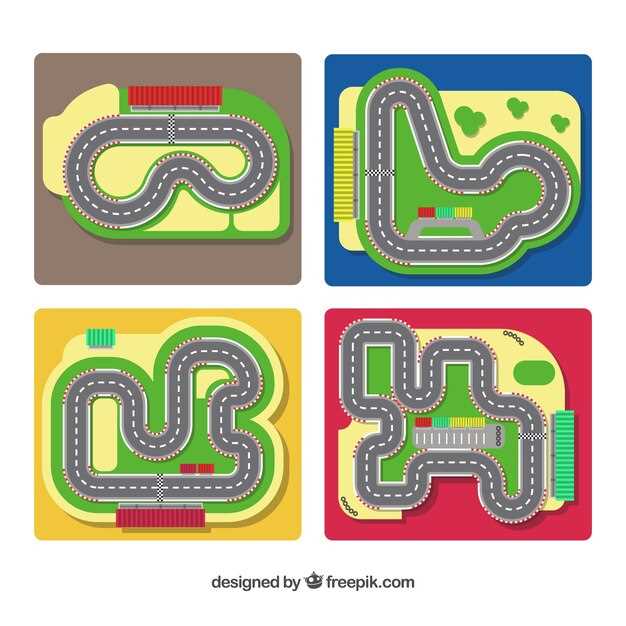
Understanding the optimal racing line is crucial for any driver looking to achieve the best performance on a circuit. The racing line is the quickest path around a track, and it varies significantly depending on the circuit’s layout, surface, and conditions. Mastering this aspect of racing not only enhances lap times but also contributes to better tire management and vehicle stability.
Different circuit configurations, such as street courses, road courses, and oval tracks, demand unique approaches to the racing line. For example, tight turns and elevation changes may require drivers to adjust their line to maximize cornering speed, while high-speed circuits might favor a straighter approach to maintain momentum.
In this article, we will explore various racing line strategies tailored to distinct track configurations. By analyzing the nuances of each circuit type, we aim to provide drivers and enthusiasts with valuable insights that can refine their racing techniques and ultimately enhance their on-track performance.
Optimal Line Selection for Tight Corners
In circuit racing, the selection of the optimal racing line through tight corners is crucial for maintaining speed and gaining an advantage over competitors. Tight corners often challenge drivers to balance their speed and control without compromising their exit performance.
To navigate tight corners effectively, drivers should adopt a late apex approach. This strategy allows for a wider entry into the turn, resulting in a smoother trajectory and improved acceleration on exit. As the car approaches the corner, the driver should position the vehicle towards the outside of the track, maximizing grip and minimizing steering input.
During the turn, it is essential to focus on maintaining consistent throttle pressure. Gradually increasing speed as the car nears the apex helps in avoiding understeer, which is common in tight corners. By selecting the apex point wisely, drivers can optimize their line to facilitate a strong exit, gaining crucial time on the circuit.
Another key consideration is the braking point. In tight corners, the driver must determine the optimal braking distance, balancing between entering the corner too fast and losing control. A well-calibrated braking technique enables drivers to transition smoothly from braking to acceleration, ensuring that the car is ready to exit the corner efficiently.
In summary, selecting the optimal line for tight corners involves a combination of a late apex approach, consistent throttle management, and precise braking. Mastering these elements allows drivers to navigate tight configurations effectively while maximizing their performance on the circuit.
Adjusting the Racing Line for Elevation Changes

When racing on circuits with varying elevation, drivers must make strategic adjustments to their racing line to optimize speed and control. Elevation changes can impact the vehicle’s balance, grip, and momentum, necessitating a nuanced approach to cornering and acceleration.
In uphill sections, it is crucial to enter corners with a slightly wider line. This allows for a better exit angle and maximizes the use of gravitational assistance when accelerating out of the turn. By positioning the car toward the outer edge of the track, drivers can carry more speed into the apex, mitigating the loss of power that comes with climbing elevation.
Conversely, during downhill sections, drivers should adopt a tighter racing line. The increased speed generated by descending gradients can lead to challenges in controlling the vehicle. By positioning the car more towards the inner part of the corner, drivers can maintain better control and avoid sliding out, which can occur due to the additional momentum gained from the hill’s slope.
Furthermore, when approaching crests, it’s essential to adjust braking points and throttle response. The visibility of the track may be limited, and drivers should be cautious about executing a traditional racing line, as the change in elevation can lead to unexpected drops or sharp turns. Anticipating these changes ensures that drivers can maintain optimal control and avoid accidents.
Understanding the specific characteristics of each circuit’s elevation changes allows drivers to make informed decisions regarding their racing line. By adapting their strategies to these unique challenges, drivers can maximize their performance, achieve faster lap times, and enhance their overall racing experience.
Strategies for Multi-APex Corners and Chicanes

Multi-apex corners and chicanes present unique challenges on a racing circuit. Drivers must master the racing line to optimize speed while navigating transitions between tight turns. To effectively tackle these sections, several strategies can be employed.
Firstly, maintaining momentum is crucial. In a multi-apex corner, approach the first apex with slightly reduced speed, allowing for a smoother transition into the subsequent turns. This technique enables the driver to maintain higher speed throughout the corner sequence instead of losing momentum by braking excessively.
Secondly, understanding the racing line becomes essential. The ideal line may vary among circuits; therefore, drivers should study track layouts during practice sessions. Utilizing simulation software can also provide insights into the most efficient pathways through these complex sections.
Choosing the right tire compound impacts grip levels, especially in intricate corners. Drivers should evaluate tire performance across different sections of the circuit to determine optimal tire selection for chicanes and multi-apex configurations, ensuring maximum traction while cutting apexes.
Positioning the car correctly before entering a chicane is vital. Enter wide and aim for the nearest apex, then quickly transition to the next apex. This requires precise steering inputs and effective throttle modulation, allowing drivers to capitalize on the aerodynamic benefits as they exit the section.
Lastly, consistency is key. Practicing the lines repeatedly can help develop muscle memory, leading to improved lap times. By focusing on these strategies, drivers can effectively navigate multi-apex corners and chicanes, enhancing their overall performance on the circuit.












